
Description
Gravitational Wave Astronomy promises to provide a revolutionary new view of the universe that can probe previously unexplored regions, including the interiors of neutron stars, collisions of black holes, which emit energy at luminosities exceeding the entire visible universe, and even remnants of the big bang. To gain new insight into the dynamics of the universe, gravitational wave astronomers need to be able to infer the nature of the sources from the observed signals. The physical parameters of these sources can be extracted from the observed signals if the dependence of the waveform on source parameters is known to sufficiently high accuracy. The success of the gravitational wave astronomy efforts therefore depends critically on advancements in Numerical Relativity, especially now that aLIGO is online.
The principal goals supported by this award are to produce waveforms for aLIGO source parameterization efforts, and to model the remnant mass, spin, luminosity, and gravitational recoil from highly-precessing spinning black hole binaries (BHBs) in order to elucidate their distributions, and also how recoils affect the distribution and growth of supermassive black holes. This research will also complement other ongoing projects of the RIT group aimed at studying electromagnetic (EM) counterparts to compact-object mergers and to model accretion disk dynamics near supermassive black holes via the inclusion of matter and EM fields in BHBs spacetimes.